
Santiniketan to get UNESCO World Heritage Site Tag
Syllabus: GS1/ Art & Culture
In News
- Santiniketan in West Bengal has been recommended for inclusion in UNESCO’s World Heritage List.
Santiniketan: Geography
- Location: Santiniketan, popularly known today as a university town, is located in the Birbhum district in West Bengal.
- Rivers: The area is flanked on two sides by the rivers, the Ajay and the Kopai.
- Khoai: Santiniketan earlier had an extensive forest cover, but substantial soil erosion gave certain areas a barren look, the resulting phenomenon is locally known as khoai.
- Khoai refers to a geological formation specifically in Birbhum, Bardhaman, and Bankura districts of West Bengal and some parts of Jharkhand.
- This geological formation is made up of laterite soil rich in iron oxide, often in the shapes of tiny hills.
History and Cultural significance
- Santiniketan is a famous cultural and heritage place of historical importance.
- It was established by Maharshi Devendranath Tagore, and later expanded by his son, Rabindranath Tagore
- Rabindranath Tagore penned many of his literary classics (namely Tagore songs, poems, novels etc) here.
- Santiniketan is also home to the Visva-Bharti University. Founded in 1921 by Rabindranath Tagore, Visva Bharati was declared to be a central university and an institute of national importance, in 1951.
- The Santiniketan campus is adorned by splendid sculptures, frescoes, murals, and paintings of Rabindranath Tagore, Nandalal Bose, Ramkinkar, Binodbehari Mukhopadhyay and others.
Festivals celebrated here
- Birbhum District, where the Santiniketan is located, is famous for its fairs and festivals like Poush Mela (December), Joydev Mela (January), Basanta Utsav/Holi in (March).
- Poush Mela is an annual fair and festival that commences on the 7th day of the month of Poush, The fair officially lasts for three days and features live performances of Bengali folk music, specially bauls.
- Bengali New year and Rabindra Janmotsav, the birthday ceremony of Kobiguru Rabindra Nath Tagore are celebrated in the Bengali month of Boisakh with great cultural fervour.
- Briksharopan, the festival of Planting Saplings, and Halakarshan, the festival of Plowing the Fields, are celebrated on 22nd And 23rd day of Sravana (August).
- Varshamangal, The festival of Rains, is celebrated during August/September.
Recommendation for inclusion in UNESCO’s World Heritage List
- The International Council on Monuments and Sites (ICOMOS), which is the advisory body to the UNESCO World Heritage Centre has recommended for inclusion of Santiniketan in UNESCO’s World Heritage List.
- Santiniketan, if selected, would be the second cultural symbol from West Bengal to make it to the UNESCO list. In 2021, UNESCO had included ‘Durga Puja in Kolkata’ in its list of Intangible Cultural Heritage of Humanity.
World Heritage Sites
- Meaning: World Heritage Sites are places of exceptional cultural or natural significance and are recognized by UNESCO under World Heritage Convention of 1972 for their outstanding universal value.
- Cultural heritage consists of monuments (such as architectural works, monumental sculptures, or inscriptions), groups of buildings, and sites (including archaeological sites).
- Natural Heritage consists of natural features (consisting of physical and biological formations), geological and physiographical formations (including habitats of threatened species of animals and plants), and natural sites which are important from the point of view of science, conservation or natural beauty.
- Governance: The World Heritage Sites list is maintained by the international World Heritage Program administered by the UNESCO World Heritage Committee, composed of 21 “states parties” that are elected by their General Assembly.
- How many? As of April 2023, a total of 1,157 World Heritage Sites (900 cultural, 218 natural, and 39 mixed properties) exist across 167 countries. The countries with the most sites are Italy (58), China (56), Germany (51), France (49), Spain (49), India (40), Mexico (35), the United Kingdom (33) and Russia (30).
Nomination process
- A country must first identify its significant cultural and natural sites in a document known as the Tentative List. A country may not nominate sites that have not been first included on its Tentative List.
- Next, it can place sites selected from that list into a Nomination File, which is evaluated by the ICOMOS and the International Union for Conservation of Nature (IUCN).
- ICOMOS and IUCN make recommendations to the World Heritage Committee for new designations. The Committee meets once a year to determine what nominated properties to add to the World Heritage List.
- To be included on the World Heritage List, sites must be of outstanding universal value and meet at least one out of ten selection criteria.
ICOMOS
- The International Council on Monuments and Sites (ICOMOS) is a professional association that works for the conservation of cultural heritage places around the world.
- ICOMOS was founded in 1965 in Warsaw (Poland) as a result of the Venice Charter of 1964 and offers advice to UNESCO on World Heritage Sites.
- It is now headquartered in Charenton-le-Pont, Paris (France).
Source: TOI
YUVA PRATIBHA – Painting Talent Hunt
Syllabus: GS 1/Art and Culture
In News
- MyGov in collaboration with the Ministry of Culture launched ‘YUVA PRATIBHA – Painting Talent Hunt’ under the aegis of Azadi Ka Amrit Mahotsav.
About ‘YUVA PRATIBHA – Painting Talent Hunt
- It is a unique opportunity for citizens across the country to display their artistic talent and skills to gain national recognition.
- India’s emerging artist, illustrator, miniaturist or portrait maker, can participate in the ‘YUVA PRATIBHA – Painting Talent Hunt’ and showcase creativity and craftsmanship on the various themes:
- Heritage & Cultural
- Valour & Patriotism
- Public Heroes & Leaders
- Nature & Environment
- Objective
- It aims to promote India’s rich heritage and culture at the grassroots level on a national scale by identifying and recognising the new art talent in various painting styles.
Styles of Painting
- Warli painting
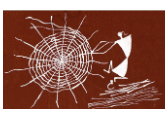
- Warli tribals of Thane district in Maharashtra decorate their house walls with paintings depicting their lives: planting saplings, carrying grain, dancing, travelling to market and other routine activities of their daily lives.
- Symbols of the sun, moon and stars along with plants, animals, insects and birds show their belief in the integration of all forms of life.
- Kavad art

- Artists in Chittorgarh, Rajasthan make wooden temples with doors that can be opened up to reveal elaborately painted stories of historical or religious importance.
- These wooden kavads are used for worship and on festive occasions
- Tanjore Painting
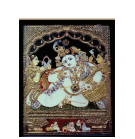
- It is an interesting combination of art and craft that grew in the region of Thanjavur, Tamil Nadu under Maratha’s influence.
- The main colours are red, yellow, black, and white. The distinctive features were aristocratic or religious figures adorned with jewellery and surrounded by elaborate architectural arches and doorways.
- Mithila painting
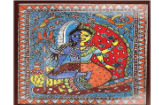
- It is popularly known as Madhubani art and is from the district of the same name in Bihar and is now well-known all over the world.
- Women decorate the nuptial chamber and the inner walls of their homes to celebrate festivals.
- The return of Ram from exile and Krishna playing with gopis are the preferred subject matter. Artists often show scenes of nature, an abundant harvest, tantric images of snake worship, and even city scenes if they have visited one.
- The jharnapatachitra of West Bengal
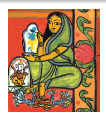
- It is a long vertical paper scroll used to tell stories from religious epics.
- The artists compose songs that they sing while they slowly unroll each scene of the painting.
- Old fabric is pasted on the back of the scroll to make it stronger.
- Pattachitra:
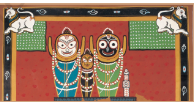
- The Pattachitra of Odisha depicts stories from the famous poem, the Geet Govind, and devotional stanzas by ancient poets, singers, and writers.
- The pat was earlier made as a temple offering. Stories are drawn in sections on palm leaf as etchings or as paintings on paper and silk.
- Deep red, ochre, black, and rich blue colours from minerals, shells, and organic lac are used in these paintings.
- Gond painting:
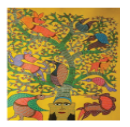
- Gonds of Madhya Pradesh have a rich tradition with their chiefs ruling over Central India. They worshipped nature.
- Paintings of Gonds of Mandla and its surrounding regions have recently been transformed into a colourful depiction of animals, humans, and flora.
- The votive paintings are geometric drawings done on the walls of huts, portraying Krishna with his cows surrounded by gopis with pots on their heads to which young girls and boys make offerings.
- Pithoro painting:

- Painted by Rathva Bhils of the Panchmahal region in Gujarat and Jhabua in the neighbouring State of Madhya Pradesh, these paintings are done on the walls of houses to mark special or Thanksgiving occasions.
- These are large wall paintings, representing rows of numerous and magnificently coloured deities depicted as horse riders
- Pata painting:
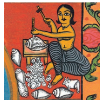
- Pata painting Done on fabric, palm leaf, or paper, scroll painting is another example of an art form practiced in different parts of the country, especially, Gujarat and Rajasthan in the West and Odisha and West Bengal in the East. It is also known as Pata, Pachedi, Phad, etc
Source: PIB
Why India is heating up slower than the world average?
Syllabus: GS1/Geography, GS3/Environment
In News
- According to the latest report of the Intergovernmental Panel on Climate Change the world is currently at around 1.1°C of warming whereas the warming trends over the Indian region are very different.
About
- The annual mean temperature of the world is known to have increased by 1.1 degree Celsius from the average of the 1850-1900 period.
- An assessment of climate change over the Indian subcontinent, published by the Ministry of Earth Sciences in 2020, said annual mean temperatures had risen by 0.7 degree Celsius from 1900.
- This is significantly lower than the 1.59 degree Celsius rise for land temperatures across the world.
- It could give the impression that the problem of climate change over India was not as acute as other parts of the world.
Temperature
- Temperature is the measure of the average heat or thermal energy in a substance.
- Air and water temperatures are primarily determined by the amount of sunlight that is absorbed by the surface of the Earth, and the amount of heat that is re-radiated in the atmosphere by the greenhouse gases.
- Atmospheric and ocean circulation redistribute heat across the surface of the Earth and shape regional temperature patterns.
Are Warming Trends Different Across the Globe?
- Average of Warming Temperature: The planet as a whole has warmed by 1.1 degree Celsius compared with pre industrial times but, this is just the average. Different regions have seen very different levels of warming.
- Arctic Region: The polar regions, particularly the Arctic, have seen significantly greater warming. The Arctic region has warmed at least twice as much as the world average. Its current annual mean temperatures are about 2 degrees Celsius higher than pre-industrial times.
- The ice cover in the Arctic is melting, because of which more land or water is getting exposed to the Sun. Ice traps the least amount of heat and reflects most of the solar radiation when compared with land or water.
- More recent research suggests that the higher warming in the polar region could be attributed to a host of factors, including the albedo effect, changes in clouds, water vapour and atmospheric temperatures.
- The warming in the polar regions account for a substantial part of the 1.1 degree Celsius temperature rise over the entire globe.
Factors that Affects the Warming of Regions
- Altitude: The increase in temperatures is known to be more prominent in the higher altitudes, near the polar regions, than near the equator.
- This is attributable to a complex set of atmospheric phenomena, including heat transfers from the tropics to the poles through prevailing systems of air circulation.
- Albedo effect: Another prominent cause is what is known as the albedo effect, or how much sunlight a surface reflects. The ice cover in the Arctic is melting, because of which more land or water is getting exposed to the Sun.
- Ice traps the least amount of heat and reflects most of the solar radiation when compared with land or water.
- Aerosols: Aerosols refer to all kinds of particles suspended in the atmosphere. These particles have the potential to affect the local temperature in multiple ways.
- Many of these scatter sunlight back, so that less heat is absorbed by the land. Aerosols also affect cloud formation. Clouds, in turn, have an impact on how much sunlight is reflected or absorbed.
- Land-Ocean Atmospheric Interactions: Variation in the amount of solar radiation absorbed, and the amount of heat re-radiating from Earth’s land and oceans results in temperature differences in air over different types of terrain.
- For example, sea breezes occur because land heats up and cools down faster than water, so that the land is warmer during the day and breezes flow from the sea inland, but the ocean is warmer than land at night, so the wind blows from land to sea.
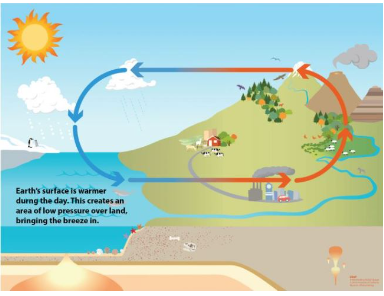
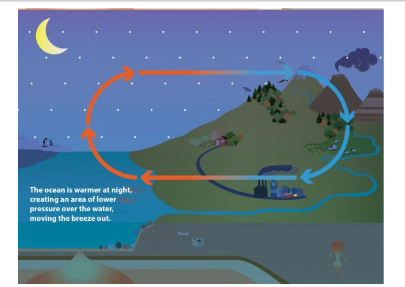
Indian Scenario
- Location: India happens to be in the tropical region, quite close to the equator. A major part of India’s relatively lesser warming can be attributed to its location in the lower latitudes. Higher latitudes experiencing greater warming are now fairly well established in science.
- A majority of the global landmass is concentrated in the northern latitudes for a country like India, located in the tropics, the deviation in temperature rise from the global average is not surprising.
- Indian Ocean: Land areas have a tendency to get heated faster, and by a larger amount, than oceans. In the tropics and along the equator, it is mostly oceans. Because of both these reasons — that lands heat up more, and most of the land is located in northern latitudes — the average warming over global land areas has become more pronounced.
- Aerosol concentration: Concentration of aerosols over the Indian region is quite high, due to natural as well as man-made reasons. Emissions from vehicles, industries, construction, and other activities add a lot of aerosols in the Indian region.
- A reduction in warming could be an unintended but positive side-effect of aerosols. They have the potential to avoid 0.1 to 0.2 degree Celsius of warming over the Indian region.
Source: IE
Troubles of India’s Aviation Industry
Syllabus: GS2/ Agreements Involving India &/or Affecting India’s Interests, GS3/ Energy
In News
- GoFirst airlines recently filed for bankruptcy at the National Company Law Tribunal (NCLT).
About
- Recent months saw several aircraft grounded at airports, frequent mid-air snags, and cancellations due to operational reasons.
- As for GoFirst, which filed for bankruptcy at the National Company Law Tribunal (NCLT), 28 of its 54 aircraft are grounded.
- Other Airlines facing troubles: GoFirst is not the only low-cost carrier currently struggling with a grounded fleet.
- In the case of SpiceJet, its aircraft in operation are now down to about 47-50 out of a total fleet of 78-80 aircraft.
India’s Aviation Sector
- About:
- A major growth engine for India, civil aviation will drive India to become a $5 trillion economy by 2024.
- India is currently the world’s 3rd-largest civil aviation market.
- Rising number of passengers & Potential of the sector:
- In March 2023, domestic carriers flew 13 million passengers, which according to the DGCA was 11% more than the same month in the pre-pandemic years of 2018 and 2019.
- As per the Civil Aviation Ministry, India will have more than 140 million passengers in FY2024 alone.
- Data on airlines:
- As of March 2023, IndiGo remained the domestic market leader with 56.8% of the market share, followed by Vistara (8.9%) and Air India (8.8%).
- AirAsia had 7.6% of the market, while GoFirst was at 6.9%, followed by SpiceJet at 6.4%.
- Policy & regulations:
- Aviation policy is broad-based in India and is dealt with by the Ministry of Civil Aviation under the legal framework of the Aircraft Act 1934, and Aircraft Rules 1937.
- The Directorate General of Civil Aviation (DGCA) is the statutory regulatory authority that comes in for issues related to safety, licensing, airworthiness, and so on.
Financial Challenges faced by India’s Aviation Sector
- Survival struggle:
- Despite being touted as the ‘fastest growing aviation sector’ in the world, airlines in the country have struggled to survive in the highly competitive and unforgiving aviation industry.
- Travel restrictions during the pandemic badly hit the coffers of all carriers, their financials were in the red earlier as well.
- In 2019-20, IndiGo was the only airline to make a profit, while all other players posted losses led by then state-run Air India at ?4,600 crore.
- Exiting due to losses:
- Financial trouble has led to the folding of major airlines in the past few decades — seventeen airlines, domestic and regional, have exited the market.
- Smaller airlines:
- Meanwhile, the consolidation of four carriers including Air India and Vistara under one umbrella by the Tatas is going to make it even tougher for smaller airlines to capture the market, pointed out CAPA in its recent report.
- Taxes on ATF:
- After 2003 when Low-cost carriers faced intense competition to keep prices low, the government levied high taxes on Aviation Turbine Fuel (ATF).
- According to estimates, while India’s airfares are 15% below the break-even point, heavily-taxed ATF contributes to the single biggest expenses of carriers.
- Hidden cost bearings:
- Airlines also have to bear costs in terms of airport fees for the use of airport facilities including aircraft landing, freight, and other charges related to the use of airport infrastructure such as runways and passenger terminals.
- Internationally, airlines pass on the bulk of these charges to passengers, however, carriers in India must remain competitive and have to offer lower ticket fares to increase reach.
- There are also high costs associated with the training of airline crew.
- The crunch in pilots is also reflective of the inadequate number of Flight Training Organisations.
- Airlines also have to bear costs in terms of airport fees for the use of airport facilities including aircraft landing, freight, and other charges related to the use of airport infrastructure such as runways and passenger terminals.
Other issues faced by the sector & way ahead
- Engine and spare parts:
- The grounding of aircraft has not resulted purely out of financial constraints.
- Engine and spare part issues have led to the grounding of 13% of the fleet of profit-making and market-leading IndiGo as well.
- Need of modern technology in aerospace:
- While the mother Act and Rules have seen frequent modifications, aviation experts argue that India has not kept pace with modern technology in aerospace and increasing costs to the industry which ultimately affects passenger growth.
- Maintenance, Repair, and Overhaul:
- Chain troubles in the recent past have substantially affected all major players, with industry experts calling for ramping up the establishment of the Maintenance, Repair, and Overhaul (MRO) segment domestically.
- Need of policy solutions:
- The onus is on the Centre to find long-term policy solutions if it wants India’s struggling airlines to reach cruising altitude.
|
UDAN Scheme
Emergency Credit Line Guarantee Scheme (ECLGS)
National Civil Aviation Policy (NCAP) 2016
Airports Authority of India (AAI)
|
Source: TH
Indian Sludge finds ‘high potential’ for use as Fertilizer
Syllabus: GS 3/Environment
In News
- A recent analysis found that sludge found in Indian sewage treatment plants (STP)has high potential for use as fertilizer but required treatment before it could be used unrestrictedly in farms, or as a potential biofuel.
About Sludge
- It is the thick residue filtered out of sewage treatment plants
- It is rich in organic chemicals and is also a repository of heavy metals, industrial effluents, and bacterial contaminants.
Classification of Treated sludge
- Treated sludge can be classified as class A or class B as per the standards of the United States Environmental Protection Agency with class A being safe to be disposed of in the open and useful as organic fertilizer.
- Class B means that the sludge can be used in “restricted” agricultural applications, the edible parts of the crop not be exposed to the sludge-mixed soil, and animals and people have not come into extensive contact.
Efforts of India
- Arth Ganga is a sustainable viable economic model conceptualized under the “Namami-Gange” program to integrate people in the basin with Ganga Rejuvenation.
- One of the measures, under this ‘Arth Ganga’ (economic value from Ganga), is to “monetize” and reuse treated wastewater and sludge.
- This means converting sludge into usable products such as manure and bricks.
- One of the measures, under this ‘Arth Ganga’ (economic value from Ganga), is to “monetize” and reuse treated wastewater and sludge.
Challenges
- India doesn’t yet have standards classifying sludge as class A or B.
- Currently, those awarded contracts for developing and maintaining STPs under the Namami Ganga Mission are also apportioned land for disposing of the sludge.
- However, this is rarely treated, and during rains, such sludge — with its accompanying chemical and metallic constituents — often makes its way back into rivers and local water sources.
- A study by the Indian Institute of Technology (IIT)-Roorkee found that most of the sludge analysed after drying fell into the class B category.
- Nitrogen and phosphorous levels were higher than those recommended by India’s fertilizer standards (FCO, 2009).
- However, the potassium levels of some sludges were less than recommended.
Suggestions
- To improve the quality of sludge, the report recommends the sludge needs to be stored for at least three months to kill pathogens, and blended with cattle manure and husk or local soil to reduce the heavy metal.
- This, however, would still put it in class B and converting it into grade A sludge would require far more extensive treatment.
- Before standards were made, it was necessary to understand the characteristics of the sludge from these STPs before ways could be devised to incentivize private players to treat and dispose of sludge.
Source: TH
Poshan Bhi, Padhai Bhi Scheme
Syllabus: GS2/ Welfare Schemes
News
- In May 2023, the Union Ministry for Women and Child Development launched the Centre’s flagship programme ‘Poshan Bhi, Padhai Bhi’.
About
- Objective: The programme will focus on Early Childhood Care and Education (ECCE) at anganwadis across the country. The aim is to make anganwadi centres as nutrition hubs as well as education-imparting centres.
- Funding: The ministry has allocated Rs 600 crore for the training of anganwadi workers to implement the ECCE.
- Governance: The National Institute of Public Cooperation and Child Development (NIPCCD) will provide training of Anganwadi workers. NIPCCD is an autonomous organization under the Union Ministry for Women and Child Development.
Strategy
- Anganwadi Centres will be strengthened with high-quality infrastructure, play equipment, and well-trained Anganwadi workers/teachers
- Every child (till the age of 6-years) would be provided with at least two hours of high-quality pre-school instruction in the mother tongue on a daily basis, as per the New Education Policy.
- Target is to ensure that the ECCE material, which was prepared based on the New Education Policy, percolates to every anganwadi in the country through new training methodologies (such as visual aids, audio aids, audio-visual and bodily-kinesthetic aids).
- Government will target children’s development in every domain mentioned in the National Curriculum Framework, viz., physical and motor development, cognitive development, socio-emotional-ethical development, cultural/artistic development, and the development of communication and early language, literacy, and numeracy.
Significance of ECCE via Anganwadi centres
- Early Childhood Care and Education (ECCE) is an important component of Mission Saksham Anganwadi and Poshan 2.0 (Mission Poshan 2.0) and the National Education Policy.
- Close to 13.9 lakh operational Anganwadi centres across the country are providing supplementary nutrition and early care and education to around 8 crore beneficiary children under the age of 6 years.
- Considering global evidence on 85% of brain development being achieved by the age of 6 years, the Anganwadi eco-system becomes a critical access point for building the children’s base.
Source: PIB
Delhi’s Draft Motor Vehicle Aggregator Scheme 2023
Syllabus: GS2/ Government policies & interventions
In News
- The Delhi government announced a draft ‘Motor Vehicle Aggregator Scheme 2023’ aimed at regulating cab aggregators and delivery service providers in Delhi.
- The draft scheme has been sent to Lieutenant Governor for approval.
Draft Motor Vehicle Aggregator Scheme 2023
- Aim: To lay the foundation for regulating aggregators and delivery service providers in Delhi.
- To prioritize the safety of passengers and ensure timely grievance redressal, while also promoting the use of electric vehicles and reducing pollution levels in Delhi.
- Key Features:
- Applicability: The Motor Vehicle Aggregator Scheme 2023 will be applicable to any person or entity that operates, on-boards, or manages a fleet of motor vehicles through digital or electronic means or any other means to ferry passengers.
- Safety Provisions: It will make it mandatory for aggregators to install a panic button and integration with 112 (Delhi Police) for emergencies.
- Grievance Redressal Mechanism: The scheme will make timely consumer grievance redressal by service providers, enforcement of vehicle fitness, pollution control, and validity of permits. It also provides for driver remedial training in instances where the driver’s performance is poor.
- Transitioning to electric vehicles: Introducing a mandatory transition of commercial vehicles from conventional vehicles to electric vehicles. Aggregators and delivery services will have to ensure that 50 per cent of all their new two-wheelers and 25 percent of new four-wheelers are electric by March 2023.
- Regulatory provision for bike taxis: Since Delhi has never permitted bike-taxis to operate in the city, the scheme provides for such services to be regulated in the city.
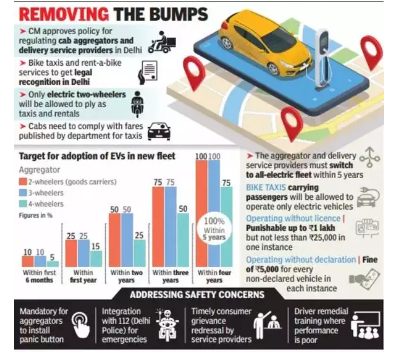
Significance
- This will reduce pollution levels in Delhi and create new opportunities for employment and economic growth.
- The scheme follows a ‘polluter pays’ principle where onboarding of any electric vehicle will have zero licence-fee.
- The scheme would properly address the safety concerns of the commuters.
Source: IE
iDrone Initiative
Syllabus: GS3/ Science and Technology
In News
- Indian Council of Medical Research (ICMR) and Union Health Ministry successfully conducted a trial run of blood bag delivery by drones under its iDrone initiative.
About i-drone Initiative
- The project ‘i-DRONE’(ICMR’s Drone Response and Outreach for North East) assessed the feasibility of using drones to deliver vaccines and medical supplies.
- ‘i-DRONE’ was first used during covid19 pandemic for distributing vaccines to unreachable areas.
- This was carried out in difficult geographical terrains including land, island, foothills and across the hills.
- The medical supplies delivered under iDrone project included COVID-19 vaccines, vaccines used in routine immunisation programs, antenatal care medicines, multi-vitamins, syringes and gloves.
- The operations connected the district hospitals to the community and primary health care centres in the districts.
Significance
- Clarity on challenge mapping and identifying the possible solutions can be achieved by developing indigenous capacities in research, and introduction of innovations and technologies in the mainstream.
- The boost of technology is an accelerator which is gradually pushing India towards achieving the status of being a developed nation.
- It will lead to development of SOPs for wider applicability and use of drones for delivery of blood bags and the components.
- Additionally, it will provide answers to whether drones shall be used as a method of transportation for temperature sensitive blood products in remote locations of the country.
- The drone-based delivery of blood will reduce the time for last-mile deliveries within the country.
|
About Indian Council of Medical Research (ICMR)
|
Source: PIB
Indo-Thai CORPAT
Syllabus: GS 3/Defence
In News
- The 35th edition of India-Thailand Coordinated Patrol (Indo-Thai CORPAT) between the Indian Navy and the Royal Thai Navy was conducted
About Indo-Thai CORPAT
- The Indian Navy and the Royal Thai Navy have been undertaking CORPAT bi-annually since 2005 along the International Maritime Boundary Line (IMBL).
- It builds up understanding and interoperability between navies and facilitates instituting measures to prevent and suppress unlawful activities like Illegal Unreported Unregulated (IUU) fishing, drug trafficking, piracy, and armed robbery.
Importance
- It is another step towards enhancing the Indian Navy’s efforts to consolidate inter-operability and forge strong bonds of friendship between India and Thailand.
- It will reinforce maritime linkages between the two countries.
- It further helps enhance the operational synergy by exchanging information for the prevention of smuggling, and illegal immigration and for the conduct of Search and Rescue (SAR) operations at sea.
|
Do you Know?
|
Source: PIB